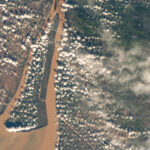Things on the surface of Venus may be moving.
Since 1983, researchers have known that strange, round landforms dot the planet’s surface. These circular mountain belts are known as coronae (Ka-ROH-nay). There’s nothing like them on Earth. So they’ve remained mysterious for decades.
A new look at old data may now have solved that mystery.
Hot plumes of rock welling up from the planet’s mantle seem to be shaping these coronae. If true, that means the surface of Venus is tectonically active.
Scientist shared these findings May 14 in Science Advances.
Anna Gülcher was part of the research team. She studies Earth and planetary science at the University of Bern in Switzerland. Some people have said that Venus is “geologically dead,” she says. But over the past few years, growing evidence has hinted that Venus is geologically active. The new work shows that hot material under the coronae is “likely driving tectonic processes that are not so different than what occurs on the Earth.”

Matching models to observations
Gülcher and her co-workers first made a computer model of the planet’s crust. A mantle is a thick layer that can separate a planet’s crust from its core. This new model showed how the crust would deform if hot plumes of material rose up from the mantle on Venus. This allowed the team to predict what the plumes and resulting coronae should look like.
Then the scientists looked at the landscapes of Venus and its gravity.
NASA’s Magellan spacecraft had collected those observations in the early 1990s. Its gravity data were key. They revealed that the density of material below the surface differed at various spots. Those variations were linked to plumes seen rising from below.
Comparing the model’s outputs to these satellite data allowed the team to identify plumes beneath 52 coronae.
The model also suggested that these plumes had been sculpting the coronae in various ways — such as subduction. That’s a process that occurs on Earth. It happens when two solid pieces of Earth’s surface — tectonic plates — collide. The force behind that pushes the edge of one plate under the edge of the other.
Venus’ surface isn’t broken up into plates as Earth’s is. But subduction may still occur there. It could take place along the edges of the coronae, Gülcher’s group says.
For instance, as a column of material rises beneath a disk of crust, it also may bulge out to the sides. That would push on the crust around the disk. If the crust is fairly strong, that surrounding crust may bend and dive down — or subduct — under the disk.
Earth’s subduction zones host the world’s largest quakes. So if there are quakes on Venus, the strongest ones likely jolt at the rims of coronae, Gülcher says.
But the crust around coronae might instead be weak. Then an upward push of material from the mantle might crack the surrounding crust. That detached crust could drip into the planet’s mantle, Gülcher says, “like honey.”
Some coronae may even form as rising plumes get lodged in the ground below the surface. That would make the crust above swell into a round landform. Think of it as a tectonic blister, says Paul Byrne. This planetary scientist works at Washington University in St. Louis, Mo. He did work on the new study.
Tectonic intrigue
The new findings support the idea that tectonics are active today, Byrne says. What’s more, it shows how useful it is to pair computer models with spacecraft data. That could be a boon to future Venus missions. The upcoming VERITAS spacecraft, for instance, will gather much more detailed data than Magellan did.
If Venus is geologically active today, perhaps it could have been Earthlike in the past, Gülcher says. It makes one wonder, she says: “Was there a period in Venus’ history that was … potentially less hot and more habitable?”




